Precious vessels
Digging isn’t good for the soil when it’s soaking wet. At this time of year, young plants get growing much faster when you plant them in a pot, much happier in sun-warmed, well-drained container mix than in cold soggy ground. Plants are also more likely to escape the peril of slugs and snails when raised off the damp ground in pots. Weeds too.
We are less likely to neglect our plants when they are close at hand in pots. Pests and diseases, though less prevalent in winter, are quickly remedied. Located in a sunny sheltered spot, plants in pots can be protected from winter weather extremes, absorbing any extra warmth radiated by walls or paving. For extra warmth add a cloche or make a cold frame out of an old window.
Best of all, container gardening is an easy, anytime project. On short winter days, it means we can enjoy a few hours out in the fresh air without leaving the deck or balcony. Pots and planters can be raised to accessible heights while making the most of any available space.
Flowers in pots can be placed close to the house where we can enjoy their cheery colour every day. Herbs and veges grown a few steps from the kitchen are super convenient for cooks, especially in winter, when it’s dark early.
Vary the look with a change of pots. Containers vary widely in shape, colour and texture, from natural stone, pottery or classic concrete to metal, ceramic and acrylic containers in beautiful bright colours.
What to plant in winter
Instant colour
Brighten dull corners between seasons with winter and spring flowering pansies, polyanthus, snapdragons, mini cyclamen and fragrant stock. Dainty alyssum and lobelia flowers make wonderful fillers.
Plant now for spring and summer
There is still time for late planting of tulips and other spring flowering bulbs for fabulous displays in pots. Lily bulbs, ready now for winter planting, will bloom in summer. Dwarf dahlias, cannas and begonias are planted in late winter or spring for late summer and autumn colour.
Foliage
Heucheras grow beautifully in pots and give lasting colourful effects with their leaves alone. Flowers are the icing on the cake.
Edibles
Grow easy leafy greens for healthy winter meals. Spinach, silverbeet and winter lettuces are vailable in punnets for quick and easy planting. Make regular weekly sowing of micro-greens in a warm spot indoors. Garlic and shallots grow well in pots too, their bulbs thriving in the extra rainage a good potting mix provides. Plant them in winter for summer harvest. Spring onion seedlings can be purchased in punnets or you can start them from seed. Potatoes are grown with ease in pots or planter bags. Start by planting the early varieties in July or August which will be ready for a pre-Christmas harvest.
For healthy winter flavour, parsley, chives, rosemary, oregano, thyme and other herbs thrive in pots. Winter is also a great time for planting strawberries in containers, ideally in a wide pot or tub. They need a generous root zone to hold plenty of water and feeding for best fruiting potential.
Plant a pansy basket
Plant a beautiful basket of cool season annuals that will grow and bloom through winter and spring.
Taranaki gardener, Jenny Oakley plants her baskets in August for spring displays. Her all-over planting method is built up in layers. This avoids the messiness that comes from planting through cut holes in the liner. Jenny folds lengths of hessian cloth into strips to make a long wad a few layers thick, using a stapler to hold it together. A strip of hessian is wrapped around the inside of the basket to hold each layer of potting mix and plants. The bottom of the basket has a layer of hessian with loose coconut fibre on top.
Jenny always fills her baskets with fresh, top quality potting mix. To this she adds long-term controlled-release fertiliser and adds more during the flowering season, sprinkling it over the top every 4 to 6 weeks. The more plants flower, the more food they need to keep them going.
TIPS
- Plant spacing depends on the plants, but generally for a full looking basket, it’s best to plant a little closer than is recommended on the label.
- Plant the top basket layer with flowers still in their little pots. Mid-season, you can simply lift them out and pop a new plant (removed from its pot) in without harming any roots.
Grow garlic in pots
You will need a NZ grown garlic bulb (imported garlic isn’t reliable). Separate your garlic bulb into cloves. Leave the papery skin on. Set aside the biggest cloves for planting.
Choose a planting mix with controlled-release fertiliser and a pot at least 25cm wide with good drainage holes. Fill a container up to 5-10cm from the top. Space cloves about 10cm apart, pointy ends facing upwards, cover with planting mix to 3-5cm above the top of the cloves (as with most bulbs, the recommended planting depth is twice their height). Water gently and place your pot in full sun and water when needed to keep the planting mix moist.
When shoots appear in spring feed with liquid fertiliser or worm tea to encourage fat healthy growth. Garlic is ready to harvest when the leaves start to turn yellow in summer.
Grow peas in pots
Buy a fresh packet of seeds for best results. In a sunny location fill a large pot or grow bag with planting mix. Mix in sheep pellets below the level you will sow the seeds (pea plants need lots of food but manure too close to seeds can rot them).
Form a teepee climbing frame using bamboo stakes and garden twine and sow your seeds about 10cm apart. (Note: In frosty climates wait until spring to sow your seed.) Water gently and apply slug bait or used coffee grounds to guard against pesky snails.
Cover the soil around your pea plants with straw to protect the roots and block weeds. For a strong start, feed seedlings with liquid fertiliser when they reach about 10cm tall.
Pick peas often. The more you pick them the more they will produce!
Grow strawberries in pots
Fill a large container with planting mix that has slow release fertiliser mixed in, then plant your strawberry plants, not too deep. The ‘crown’ (where the stems join the roots) should sit on the soil surface. Water thoroughly. Feed with liquid fertiliser every week after plants start flowering. Bird netting is recommended to block these thieves.
Grow potatoes in bags
In a sunny location, fill a large grow bag (or any large container with drainage holes in the bottom) with planting mix up to 15 or 20cm deep. Place three or four seed potatoes on top, then cover with more planting mix. Water to keep the mix just moist. When the green shoots grow to about 15cm above the soil, add more planting mix, leaving about 5cm of the leaves uncovered. Repeat this until the container is full. Feed once a month with liquid fertiliser.
Early potatoes are ready for harvest 80-90 days after planting. Tip the container over and collect your treasure!
TIPS
- Vegetables and fruiting plants need plenty of sun.
- For the best nutrition and flavour, pick fresh for each meal.
- The smaller your container, the more you need to feed and water.

15-Jun-2022
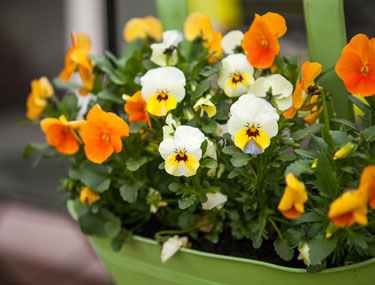
Violas
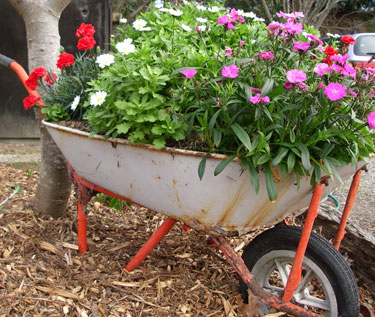
An old wheelbarrow makes a good container for perennial and annual flowers and is easy to relocate.
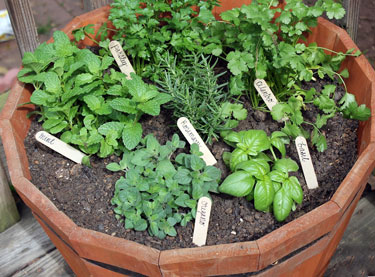
A wooden barrel is an excellent vessel for a mixed herb garden.
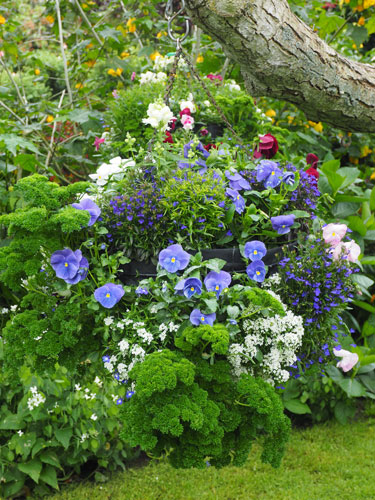
A colourful hanging basket of pansies, alyssum and parsley.
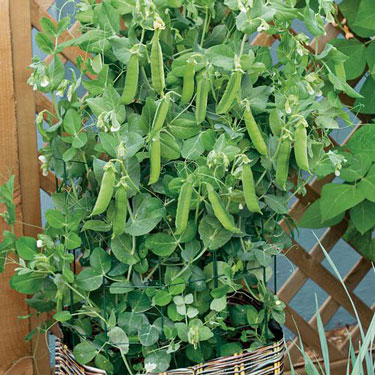
Peas can be grown in containers with quality potting mix and support.
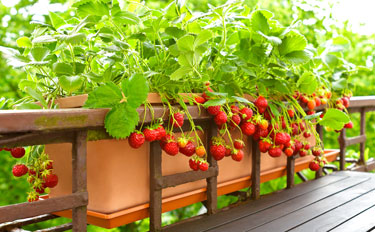
Strawberries grow well in a trough on a balcony.
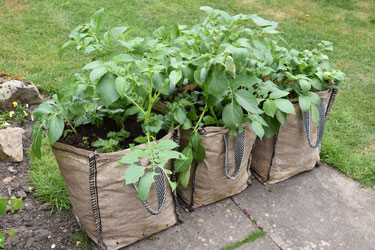
Potatoes grow well in bags with quality potting mix and food.

